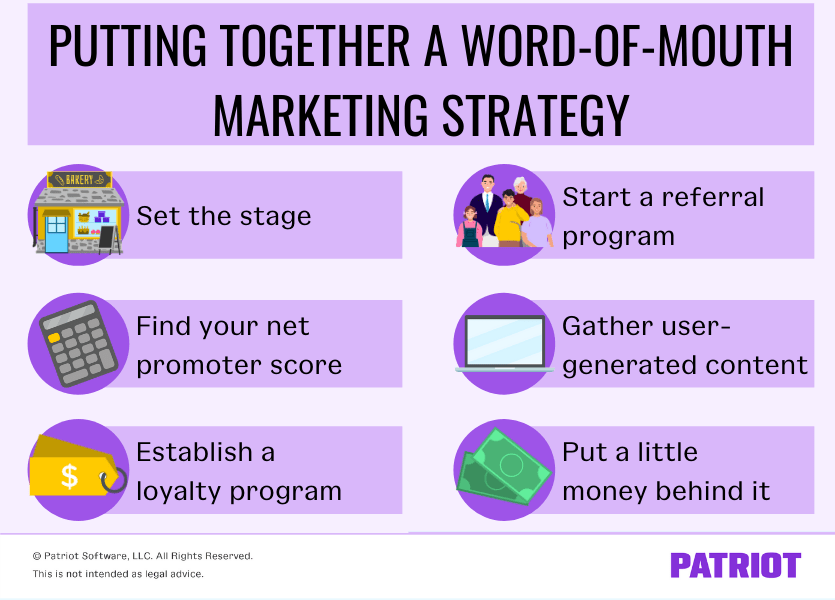Hey there, how’d you hear about us? From a friend? Family member? Social media? Great. That’s word-of-mouth marketing in action. And if you want to reap the benefits of virtually free advertising, you might consider putting together a word-of-mouth marketing strategy.
Read on for a word-of-mouth marketing definition, followed by six steps you can use to put together your own strategy.
What is word-of-mouth marketing?
Word-of-mouth marketing (also called WOM or WOMM) is when a business encourages consumers to talk about them in a positive way. This can result in increased brand awareness, as well as prompt others to buy from the company. WOM marketing can take place in conversation, on social media, on a blog, or through review sites.
So, what are the benefits of word-of-mouth marketing?
WOMM is powerful. According to one study, 83% of respondents said they trust their friends’ and families’ recommendations when it comes to shopping. And, 66% of consumers trust consumer opinions they find online.
Consider how much of an impact word-of-mouth marketing has had on your own purchasing decisions. Cars, clothing, and food are just some of the popular buys you might have made thanks to WOM marketing.
In many cases, word-of-mouth marketing happens naturally. A consumer loves a product or service and wants to tell the world about their great experience. But sometimes, a business needs to encourage consumers to talk.
Both situations start with a word-of-mouth marketing strategy.
How to put together a word-of-mouth marketing strategy
Ready to take your marketing up a level? Use the following tips to put together your word-of-mouth strategy.

1. Set the stage
Before you start asking customers to spread the word about your business, you need to first set the stage. Build a brand that consumers want to get behind; a business that offers something so great that customers will be dying to tell others about before you even have to ask.
First, give customers something to talk about. Think about why you listened to a friend, a family member, or someone on the internet when they recommended something. What was it about that brand that drew you—and them—in?
There are a number of things that increase brand loyalty. So, what do customers want?
To build up your business into a brand customers are passionate about, you can prioritize:
- Customer service
- Transparency
- Personalization
- User experience (UX) on your website
2. Find your net promoter score
Would your customers recommend your business? You don’t need to take a guess. You can find out through your net promoter score (NPS).
A net promoter score shows you what percentage of your customers would recommend your business.
To find your net promoter score, use a 0 – 10 scale and ask customers, “How likely would you recommend us to a friend or colleague?” It’s as simple as that. You can email a survey to customers with the question or distribute paper surveys in-store.
Here’s what customer responses mean for your NPS (and the future of your word-of-mouth marketing strategy):
- 9 – 10: Promoters who will recommend you to others
- 7 – 8: Passives who might not recommend you to others
- 0 – 6: Detractors who might negatively talk about you to others
Low net promoter score? That’s OK. Take actions to build it up (i.e., set the stage to build a brand customers are passionate about).
3. Establish a loyalty program
A loyalty program can do a lot more than encourage customers to keep spending at your business. It can also inspire enough loyalty to prompt customers to tell their friends.
Through a loyalty program, you can offer customers who frequent your business rewards. You might set it up so customers get a reward when they make X amount of purchases or spend $X at your store.
Although it’s not a program that’s directed at WOMM, a loyalty program could get customers talking about your business.
4. Start your own referral program
Refer-a-friend programs are a direct way to get customers to get their friends and colleagues to buy from you.
Why? It’s a win-win situation.
Your customer talks about you, and they get a reward when the person they referred buys from you. Sometimes, the person being referred gets a reward, too.
Rewards can include:
- Store credit
- Free gift
- Discounts
- Subscription
- Membership
- Upgrades
By establishing a referral program, you can encourage your current brand ambassadors to stay loyal to your brand and get new customers, too. And the new customers can then tell their friends and get a reward … and so on and so on.
5. Gather user-generated content
Want to know your customers are talking about you? Want it in writing? You can—by perusing and gathering user-generated content.
User-generated content (UGC) is content that individuals write or create (e.g., visuals), leading to brand exposure. Examples of user-generated content include reviews, social media posts, or blog articles that mention a business brand.
When you have customers or brand followers writing about your business, consider sharing it. You might look into adding reviews or screenshots to your business website or sharing on social media.
6. Put a little money behind it
Customers naturally telling others about your business is a beautiful thing. But if you want to increase your reach, you can put a little money behind it.
Consider doing some paid advertising using the glowing reviews you gather from your customers to get in front of a larger audience on social media.
You can also encourage more customers to leave your business reviews on review sites in exchange for a reward (e.g., discount, gift card, etc.).
This is not intended as legal advice; for more information, please click here.



